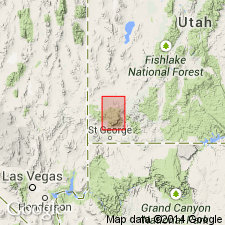
- Usage in publication:
-
- Grass Valley formation
- Modifications:
-
- Named
- Dominant lithology:
-
- Limestone
- Andesite
- Ignimbrite
- AAPG geologic province:
-
- Great Basin province
Summary:
Probably named for exposures in Grass Valley, Washington Co, UT, Great Basin province. No type locality designated. Also outcrops in Grassy Flat Canyon and in area northwest and west of Pine Valley. Consists of (ascending): basal lacustrine limestone (0-100 ft thick), augite andesite lava (0-50 ft thick), vitric-crystal rhyolite ignimbrite with lithic fragments (0-700 ft thick), and foliated vitric-crystal rhyolite ignimbrite (0-150 ft thick). Maximum thickness of Grass Valley is 1000 ft. Limestone is dominantly white with some pale pink bands; displays thin, irregular bedding; rock is hard, dense, and pure. Andesite flow is dull black with sparse gray amygdules and plagioclase and augite phenocrysts; phenocrysts make up about 50 percent of rock. Lower ignimbrite breaks in a clean fracture exposing red-violet color; contains small, angular orange-red lithic fragments; lithics and crystals of feldspar and biotite constitute 30 percent of rock. Upper ignimbrite contains about 35 percent crystals (mainly feldspar) and 15 percent white devitrified glass (and holes) in brick-red, stony groundmass. Unconformably (or in thrust fault contact) overlies Rencher formation (new); unconformably underlies Atchinson formation (new). Geologic map; stratigraphic chart; cross sections. Assigned Tertiary age.
Source: GNU records (USGS DDS-6; Denver GNULEX).
For more information, please contact Nancy Stamm, Geologic Names Committee Secretary.
Asterisk (*) indicates published by U.S. Geological Survey authors.
"No current usage" (†) implies that a name has been abandoned or has fallen into disuse. Former usage and, if known, replacement name given in parentheses ( ).
Slash (/) indicates name conflicts with nomenclatural guidelines (CSN, 1933; ACSN, 1961, 1970; NACSN, 1983, 2005, 2021). May be explained within brackets ([ ]).

